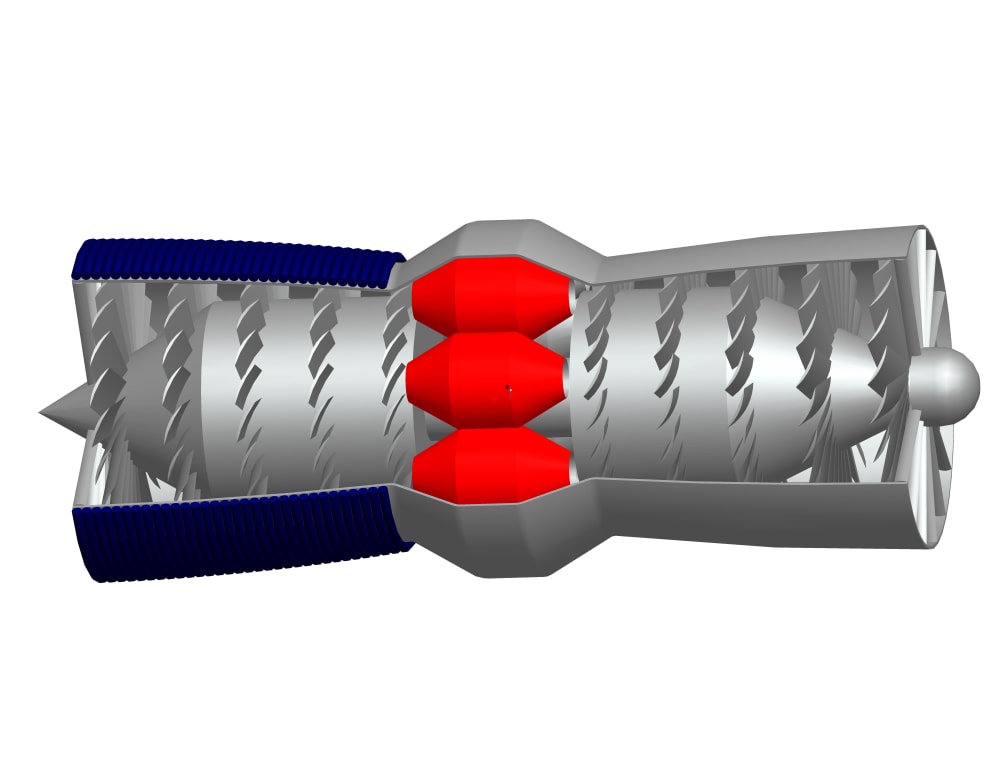To make a super-efficient environmentally-friendly engine, one would like to utilize two processes where the waste of the first process becomes the fuel of the second process.
A gas turbine is highly efficient because it burns fuel at high temperatures and because it maintains a constant speed at its most fuel efficient velocity. Because of this, it exhausts huge amounts of waste heat. A typical automotive combustion engine cannot exceed 25% efficiency because of the nature of the four stroke engine. A gas turbine typically achieves about 32% efficiency.
A steam turbine utilizes a boiler to superheat water into steam. Steam turbines can also achieve about 32% efficiency.
If the Mini Combo Turbine must run at a constant velocity, then how can it allow a vehicle to start and stop? By adding a flywheel to our system, the turbine can accelerate the flywheel instead of the vehicle. The spinning flywheel can then be used to accelerate the vehicle. Additionally, braking of the vehicle can accelerate the flywheel again. By recovering braking energy, we can hope to manufacture up to an additional 11% efficiency.
If a lightweight 25% efficient combustion engine can achieve up to 40 mpg then a Mini Combo Turbine can achieve 32% (gas turbine) plus 32% (steam turbine) plus 11% (flywheel braking regeneration) = 75% efficiency which would achieve 120 miles per gallon.
There is an added bonus to the gas turbine system. Because fuel is burned at such high temperatures, any type of fuel can be used, and that fuel will be burned almost completely. Pollutants are considerably less than a typical four-stroke combustion engine. This means that smog equipment would be unnecessary on a Mini Combo Turbine automobile.
Turbines are typically expensive to manufacture. Blade design is always on the cutting edge of material and thermodynamic engineering. Also, after assembly, they need to be balanced perfectly. This means that thousands would have to be manufactured before they could hope to be priced competitively with typical combustion automobiles. The first Mini Combo Turbine would probably cost about $25,000. On a robotic assembly line, the cost would likely be brought down to between $2000 and $5000 per turbine.
The model pictured has a 12” diameter and is 36” long. One quarter of the housing has been cut away for clarity. Preliminary calculations show that it will produce between 200 and 300 horsepower. This means that it would need to be scaled down closer to 100 horsepower to achieve the 120 mpg goal. Also there are 5 compression blades shown, 3 gas turbine drive blades and 2 steam turbine drive blades. A typical turbine would have many more compression blades than drive blades. In the Pro/E model, these were patterned over a distance. The number of blades can be changed easily for multiple CFD analyses to optimize fuel economy.
Like this entry?
-
About the Entrant
- Name:Frederick Burke
- Type of entry:individual
- Software used for this entry:Pro/E Wildfire 3.0
- Patent status:none





